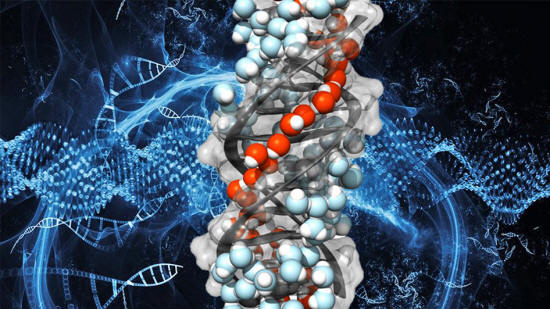|
Researchers at the University of Notre Dame have observed for the first time a chiral water superstructure templated around a biomolecule.
Although many studies have demonstrated the direct interaction of water with highly important macromolecules like DNA, the latest study is a final confirmation that water forms a unique and enduring super-structure around the DNA double helix - stabilizing the molecular conformation, mediating its functionality and interaction with important information intermediaries like RNA polymerase.
Taken in consideration with other recent reports, such as the direct mapping of molecular couplings and energy exchange between DNA backbone vibrations and water with femtosecond infrared spectroscopy, it is becoming increasingly difficult to ignore the central role of water in some of the most important of biological functions.
Water forms hydration patterns around biomolecules via hydrogen bond interactions - and is so crucial in organizing and orchestrating the cellular environment that researchers like Gerald Pollack have even highlighted its importance as the possible progenitor to the cellular membrane - giving birth to the first cells of life.
The latest study used coherent nonlinear vibrational microscopy for unprecedented vibrational imaging speeds and molecular spatial resolution, allowing DNA molecules and the associated hydration patterns of water to be observed in high detail at near-physiological conditions (room temperature and 100 mM NaCl solution).
The research team found that DNA imprints its chirality (think left-handed versus right-handed orientations) on the surrounding water molecules, causing the formation of a macroscopic super-structure of water template along the DNA double helix.
While it is known that the specific template patterning of water molecules along the DNA molecule is important for recognition of gene promoter sequences by interacting proteins (see for example the study 'interfacial water as a hydration fingerprint'), the complete biological relevance of a chiral spine of hydration is unknown.
Although, it does lend support for controversial findings like that of Luc Montagnier - in which the Nobel laureate and his research team, including the theoretical physicist Emilio Del Giudice who pioneered work on the quantum field theory of condensed soft matter, especially water - performed a series of experiments that suggests DNA sequences can be reconstituted from water memory.
The study is detailed in the report "Transduction of DNA information through Water and Electromagnetic Waves".
The ability to directly detect water's interaction and pivotal role in biomolecular functions is an exciting development of advanced spectroscopic technologies and molecular biology and will provide revelatory insights into the biophysics and physico-chemical properties at the molecular level of life.
Reference Article
|


